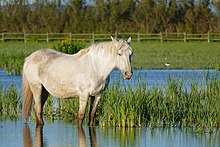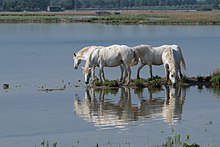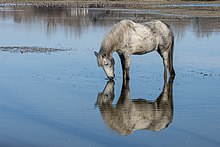For other uses, see Camargue (disambiguation).
| This article includes a list of general references, but it lacks sufficient corresponding inline citations. Please help to improve this article by introducing more precise citations. (December 2023) (Learn how and when to remove this message) |
 | |
 Guardians in parade, 2023 Guardians in parade, 2023 | |
| Conservation status | |
|---|---|
| Other names |
|
| Country of origin | France |
| Traits | |
| Weight |
|
| Height |
|
| Colour | grey |
| Breed standards | |
The Camargue, French: Camarguais or Cheval de Camargue, is a traditional French breed of working horse indigenous to the Camargue area in southern France. Its origins are unknown. For centuries, possibly thousands of years, these small horses have lived wild in the harsh environment of the Camargue marshes and wetlands of the Rhône delta, which covers part of the départements of Gard and Bouches-du-Rhône. There they developed the stamina, hardiness and agility for which they are known today. Traditionally, they live in semi-feral conditions in the marshy land of the region. The Camargue horse is the traditional mount of the gardians, the Camargue riders who herd the black Camargue bulls used for courses camarguaises in southern France.
History

Some researchers believe the Camargue are descended from the Solutré horse hypothesised from archeological remains found in Burgundy. The Camargue horses were appreciated by the Celtic and Roman invaders who entered the Iberian Peninsula. Their genealogy is closely tied with Iberian horses, especially those of the northern part of the peninsula.

A breed society, the Association des Eleveurs de Chevaux de Race Camargue, was established in 1964. In 1976, to preserve the standards and purity of the breed, the French government set breed standards and started registering the main breeders of the Camargue horse. In 1978, they set up the breed stud book. To be registered, foals must be born out of doors and must be seen to suckle from a registered mare as proof of parentage. Foals born inside the defined Camargue region are registered sous berceau, while those born elsewhere are registered hors berceau ("outside the cradle" or "birthplace"). They have the heavy, square heads of primitive horses, but the influence of Arabian, Barb and Thoroughbred blood can also be seen. The gardians look after the horses, which are rounded up annually for health inspections, branding, and gelding of unsuitable stock.
The conservation status of the Camargue was listed in DAD-IS in 2023 as 'not at risk', based on a reported population in 2018 in France of just over 14500 head, including more than 7100 brood-mares and almost 1800 stallions. These figures are widely at variance with those provided by the Haras Nationaux, which for 2018 reports 200 active stallions and 929 mares mounted.
The population is concentrated in southern France. Of just over 600 foals born and registered in 2017, almost 50% were in Occitanie and over 40% in Provence–Alpes–Côte d'Azur; of the remaining 7%, about half were born in Auvergne-Rhône-Alpes. Small numbers are also present in Germany, in Sweden and in the United Kingdom.
The Camargue horse was introduced in the 1970s to the Po delta in Italy, where under the name 'Cavallo del Delta' it is treated as an indigenous breed. In 2011 the registered population numbered 163.
Characteristics

Camargue horses are always grey. This means that they have black skin underlying a white hair coat as adult horses. They are born with a hair coat that is black or dark brown in colour, but as they grow to adulthood, their hair coat becomes ever more intermingled with white hairs until it is completely white. They are small horses, generally standing 135–150 centimetres (13.1–14.3 hands) at the withers, and weighing 350 to 500 kg (770 to 1100 lb). Despite their small size, they have the strength to carry grown adults. Considered rugged and intelligent, they have a short neck, deep chest, compact body, well-jointed, strong limbs and a full mane and tail.
The head has many similarities to the Barb horse. It is often heavy, square and expressive, with bright, wide-set eyes, a straight profile, flat forehead and well-chiseled cheek bones. The ears are small, short, and set well apart. The forelock is full. The breed has a neck of medium length with an abundant maneThe chest is deep and wide, and the shoulder is powerful and muscular. The withers must be defined but not exaggerated. The Camargue horse has a medium length back, well-supported, and a slightly sloping full croup, well-muscled hindquarters, and a low set, full tail. The Camargue horse has long legs which are well proportioned, strong and resistant, with large knees and hocks. Their hooves are hard and tough, with soles that are large and wide, suited to its original marshy habitat.
Registration
Since 2003, three registration categories exist to identify Camargue horses:
- Camargue
- Horses registered in the stud book, foaled and identified in Camargue area, branded before weaning, and from a manade (a small, semi-feral herd structure). The berceau or cradle of the breed is strictly defined, and consists of 45 communes in the départements of Bouches-du-Rhône, Gard and Hérault.
- Camargue hors manade
- Horses registered in the stud book, foaled and identified in Camargue area, and not from a manade.
- Camargue hors berceau
- Horses registered in the stud book, foaled and identified outside of the Camargue area.
There exists a strong sense of regionalism in Camargue area, so registration for the horses is treated similarly to an Appellation d'origine contrôlée.
Terminology

There is a specific terminology in the Provençal dialect that is used when discussing Camargue horses:
| English term | Term in Provençal dialect |
|---|---|
| Camargue stallion | Grignon or grignoun |
| Feral horse | Rosso |
| Yearling | Court |
| Horse or bull aged 2 years | Doublen |
| Horse or bull aged 3 years | Ternen |
| Horse or bull aged 4 years | Quatren |
| Horse breeding in Camargue area | Cavalot |
| Livestock branding in Camargue area | Ferrade |
| Herder | Gardian, and gardianou for young apprentices |
| Semi-feral herd of cows and / or Camargue horses | Manade |
Use

The Camargue horse is the traditional mount of the gardian. It is used for livestock management, particularly of Camargue cattle, and also in competitive Camargue equitation, in traditional activities such as the abrivado preceding the course camarguaise, and in many gardian games.
Their calm temperament, agility, intelligence and stamina has resulted in these horses being used for equestrian games, dressage, and long-distance riding, which is growing in popularity in France.
Film portrayal
The 1953 children's film Crin-Blanc, English title White Mane, portrayed the horses and the region. A short black-and-white film directed by Albert Lamorisse, director of Le ballon rouge (1956), Crin-blanc won the 1953 Prix Jean Vigo and the short film Grand Prix at the 1953 Cannes Film Festival, as well as awards at Warsaw and Rome. In 1960 Denys Colomb Daunant, writer and actor for Crin-blanc, made the documentary Le Songe des Chevaux Sauvages, "Dream of the Wild Horses". It featured Camargue horses and slow motion photography, and won the Small Golden Berlin Bear at the 1960 Berlin International Film Festival.
See also
References
- Barbara Rischkowsky, Dafydd Pilling (editors) (2007). List of breeds documented in the Global Databank for Animal Genetic Resources, annex to The State of the World's Animal Genetic Resources for Food and Agriculture. Rome: Commission on Genetic Resources for Food and Agriculture, Food and Agriculture Organization of the United Nations. ISBN 9789251057629. Archived 23 June 2020.
- ^ Breed data sheet: Camargue / France (Horse). Domestic Animal Diversity Information System of the Food and Agriculture Organization of the United Nations. Accessed December 2023.
- ^ Élise Rousseau, Yann Le Bris, Teresa Lavender Fagan (2017). Horses of the World. Princeton: Princeton University Press. ISBN 9780691167206.
- Caroline Davis (1998) The kingdom of the horse: a comprehensive guide to the horse and the major breeds. New York: Howell Book House. ISBN 9780876050378 p.65
- Le Musée: "Solutré, Musée Départemental de Préhistoire" (in French). Solutre.com, archived 16 July 2011.
- Bonnie L. Hendricks (). International Encyclopedia of Horse Breeds. University of Oklahoma Press. ISBN 9780806138848 p. 96.
- Origine de l'association (in French). Association des Eleveurs de Chevaux de Race Camargue. Accessed December 2023.
- ^ (2010). Le Camargue (in French). Les Haras Nationaux. Accessed August 2011.
- ^ Transboundary breed: Camargue. Domestic Animal Diversity Information System of the Food and Agriculture Organization of the United Nations. Accessed December 2023.
- Norme tecniche del Registro Anagrafico delle razze equine ed asinine a limitata diffusione Associazione Italiana Allevatori (in Italian). Accessed September 2011.
- Anagrafe equidi: Equidi per regione Archived 2011-09-10 at the Wayback Machine Anagrafe degli equidi (in Italian) Accessed September 2011.
- ^ "Règlement du stud-book du Cheval Camargue" [Rules of the Camargue Horse Stud-book] (PDF). Haras Nationaux (in French). Archived from the original (PDF) on 28 November 2006.
- Jocelyne Bonnet, La fabrication des mythes: Une approche ethno-historique du cheval camarguais (ethnology thesis) Université Montpellier III (in French) "The fabrication of myths: an ethno-historic approach to the Camargue horse"
- Pierre Macaire (). Saint-Gilles, Aigues-Mortes, Le Grau-du-Roi et la Camargue (in French). Series title: 'Au cours du Vidourle'. : Le plein des sens. ISBN 9788790493738 pp.56-57
- John Wakeman (1987). World Film Directors: 1945-1985. New York: H.W. Wilson ISBN 9780824207571 p.553.
- Journal of the University Film Association, Volumes 22-25. University Film Association 1970 p.67.
External links
- Doggett, Drew (director) (23 September 2016). Band of Rebels: White Horses of Camargue – via YouTube.
- Schmelz, Dennis (camera edit) (10 October 2019). White Angels of Camargue - Europe's Last Cowboys – via YouTube.
| Horse breeds of France | |
|---|---|
| Extant | |
| Merged into other breeds | |
| Extinct | |
| Related | |
| Category:Horse breeds originating in France | |